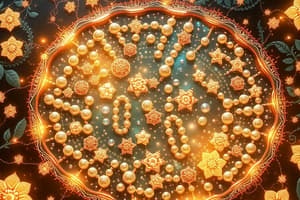Podcast
Questions and Answers
Which function of membrane proteins is most directly involved in cell communication during immune responses?
Which function of membrane proteins is most directly involved in cell communication during immune responses?
- Transport
- Enzymatic activity
- Attachment to the cytoskeleton
- Cell-cell recognition (correct)
What characteristic of the lipid bilayer primarily facilitates the rapid passage of nonpolar molecules?
What characteristic of the lipid bilayer primarily facilitates the rapid passage of nonpolar molecules?
- Hydrophobic nature (correct)
- Presence of transport proteins
- Incorporation of carbohydrates
- High viscosity of the membrane
Which type of transport protein specifically facilitates the movement of water across the plasma membrane?
Which type of transport protein specifically facilitates the movement of water across the plasma membrane?
- Carrier proteins
- Receptor proteins
- Aquaporins (correct)
- Glycoproteins
Which of the following statements accurately describes the role of membrane carbohydrates?
Which of the following statements accurately describes the role of membrane carbohydrates?
Which function of membrane proteins does not directly involve transferring substances across the membrane?
Which function of membrane proteins does not directly involve transferring substances across the membrane?
What characterizes phospholipids in the plasma membrane?
What characterizes phospholipids in the plasma membrane?
Which statement about the fluidity of membranes is true?
Which statement about the fluidity of membranes is true?
What role do integral proteins play in the plasma membrane?
What role do integral proteins play in the plasma membrane?
Which of the following is NOT a function of membrane proteins?
Which of the following is NOT a function of membrane proteins?
What is the correct description of the fluid mosaic model?
What is the correct description of the fluid mosaic model?
Study Notes
Membrane Structure and Function
- The plasma membrane separates living cells from their environment and has selective permeability.
- Cellular membranes consist of a fluid mosaic of lipids and proteins, primarily phospholipids.
Fluid Mosaic Model
- Phospholipids are amphipathic, having both hydrophobic (water-repelling) and hydrophilic (water-attracting) regions.
- The fluid mosaic model describes membranes as dynamic structures with various proteins embedded.
Membrane Fluidity
- Phospholipids can move laterally within the bilayer, with lateral movement occurring approximately 10 million times per second.
- Flip-flopping of molecules across the membrane is infrequent, occurring approximately once per month.
- Temperature affects membrane fluidity; membranes rich in unsaturated fatty acids remain more fluid than those rich in saturated fatty acids.
Membrane Proteins and Their Functions
- Membrane proteins are diverse and crucial for membrane functionality, categorized as peripheral (bound to the membrane surface) and integral (spanning the membrane).
- Transmembrane proteins are integral proteins that extend across the lipid bilayer.
- Six significant functions of membrane proteins include:
- Transporting substances
- Enzymatic activity
- Signal transduction
- Cell-cell recognition
- Intercellular joining
- Attachment to the cytoskeleton and extracellular matrix (ECM)
Role of Membrane Carbohydrates
- Cells recognize each other through surface molecules, often carbohydrates on the extracellular surface of the plasma membrane.
- Carbohydrates can attach to lipids (glycolipids) or proteins (glycoproteins).
Selective Permeability of Plasma Membranes
- Plasma membranes regulate material exchange with the environment, allowing selective permeability to maintain cellular function.
Permeability of the Lipid Bilayer
- Hydrophobic (nonpolar) molecules can pass through the lipid bilayer rapidly.
- Polar molecules, such as sugars, have difficulty crossing the membrane without assistance.
Transport Proteins
- Transport proteins facilitate the movement of hydrophilic substances across the membrane.
- Channel proteins form hydrophilic channels, allowing specific ions or molecules, like water through aquaporins, to pass.
- Carrier proteins bind to substances and change shape to shuttle them across the membrane, exhibiting specificity for the molecules transported.
Studying That Suits You
Use AI to generate personalized quizzes and flashcards to suit your learning preferences.
Description
Explore the intricate world of cell membranes through this quiz. Discover the fluid mosaic model, understand the role of phospholipids, and learn about membrane fluidity and protein functions. Test your knowledge on how these components work together to maintain cellular integrity.



